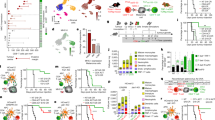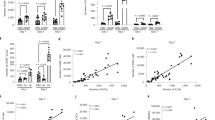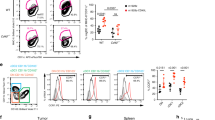Abstract
Activation of the cell-surface antigen CD95 induces apoptosis of CD95-bearing tumor cells. In this study, we investigated the antitumor effect of locally produced CD95 ligand (CD95L) on CD95-negative tumor cells in vivo. Introduction of CD95L cDNA into murine tumor cells did not affect growth in vitro but caused rejection in vivo. Neutrophils were primarily responsible for this rejection. A CD8+ T cell-mediated protective immunity against subsequent challenge with parental tumor cells was also elicited. These results provide evidence for the potential utility of CD95L in tumor eradication and also reveal a proinflammatory function of CD95L.
This is a preview of subscription content, access via your institution
Access options
Subscribe to this journal
Receive 12 print issues and online access
$209.00 per year
only $17.42 per issue
Buy this article
- Purchase on Springer Link
- Instant access to full article PDF
Prices may be subject to local taxes which are calculated during checkout
Similar content being viewed by others
References
Havell, E.A., Fiers, W. & North, R.J. The antitumor function of tumor necrosis factor (TNF). J. Exp. Med. 167, 1067–1085 (1988).
Beutler, B. & Cerami, A. The biology of cachectin/TNF: A primary mediator of the host response. Anna. Rev. Immunol. 7, 625–655 (1989).
Colombo, M.P. & Forni, G. Cytokine gene transfer in tumor inhibition and tumor therapy; where are we now? Immunol. Today 15, 48–51 (1994).
Fearon, E.R. et al. lnterleukin-2 production by tumor Cell bypasses T helper function in the generation of an antitumor response. Cell 60, 397–403 (1990).
Hock, H. et al. Mechanisms of rejection induced by tumor Cell-targeted gene transfer of interleukin 2, interleukin 4, interleukin 7, tumor necrosis factor, or interferon γ. Proc. Notl. Acad. Sci. USA 90, 2774–2778 (1993).
Cavallo, F. et al. Role of neutrophils and CD4+ T lymphocytes in the primary and memory response to nonimmunogenic murine mammary adenocarcinoma made immunogenic by IL-2 gene transfection. J. Immunol. 149, 3627–3635 (1992).
Maass, G. et al. Priming of tumor-specific T Cells in the draining lymph nodes after immunization with interleukin 2-secreting tumor Cells: Three consecutive stages may be required for successful tumor vaccination. Proc. Natl. Acad. Sci. USA 92, 5540–5544 (1995).
Tepper, R.I., Pattengale, P.K. & Leder, P. Murine interleukin-4 displays potent antitumor activity in vivo. Cell 57, 503–512 (1989).
Tepper, R.I., Coffman, R.L. & Leder, P. An eosinophil-dependent mechanism for the antitumor effect of interleukin-4. Science 257, 548–551 (1992).
Golumbek, P.T. et al. Treatment of established renal cancer by tumor Cells engineered to secrete interleukin-4. Science 254, 713–716 (1991).
Hock, H., Dorsch, M., Diamantstein, T. & Blankenstein, T.J. Interleukin 7 induces CD4+ T Cell-dependent tumor rejection. J. Exp. Med. 174, 1291–1298 (1991).
Watanabe, Y. et al. Exogeneous expression of mouse interferon-gamma cDNA in mouse neuroblastoma C1300 Cells results in reduced tumorigenicity by augmented antitumor immunity. Proc. Natl. Acad. Sci. USA. 86, 9456–9460 (1989).
Blankenstein, T. et al. Tumor suppression after tumor Cell-targeted tumor necrosis factor α gene transfer. J. Exp. Med. 173, 1047–1052 (1991).
Asher, A.L. et al. Murine tumor Cells transduced with the gene for tumor necrosis factor-α: Evidence for paracrine effects of tumor necrosis factor against tumors. J. Immunol. 146, 3227–3234 (1991).
Suda, T., Takahashi, T., Golstein, P. & Nagata, S. Molecular cloning and expression of the Fas ligand, a novel member of the tumor necrosis factor family. Cell 75, 1169–1178 (1993).
Suda, T. et al. Expression of the Fas ligand in Cells of T Cell lineage. J. Immunol. 154, 3806–3813 (1995).
Arase, H., Arase, N. & Saito, T. Fas-mediated cytotoxicity by freshly isolated natural killer Cells. J. Exp. Med. 181, 1235–1238 (1995).
Kayagaki, N. et al. Metalloproteinase-mediated release of human Fas ligand. J. Exp. Med. 182, 1777–1783 (1995).
Trauth, B.C. et al. Monoclonal antibody-mediated tumor regression by induction of apoptosis. Science 245, 301–305 (1989).
Yonehara, S., Ishii, A. & Yonehara, M. A Cell-killing monoclonal antibody (anti-Fas) to a Cell surface antigen co-downregulated with the receptor of tumor necrosis factor. J. Exp. Med. 169, 1747–1756 (1989).
Ogasawara, J. et al. Lethal effect of the anti-Fas antibody in mice. Nature 364, 806–809 (1993).
Rensing-Ehl, A. et al. Local Fas/APO-1 (CD95) ligand-mediated tumor Cell killing in vivo. Eur. J. Immunol. 25, 2253–2258 (1995).
Yagita, H., Seino, K., Kayagaki, N. & Okumura, K. CD95 ligand in graft rejection. Nature 379, 682 (1996).
Abreu-Martin, M.T., Vidrich, A., Lynch, D.H. & Targan, S.R. Divergent induction of apoptosis and IL-8 secretion in HT-29 Cells in response to TNF-α and ligation of Fas antigen. J. Immunol. 155, 4147–4154 (1995).
Tanaka, M., Suda, T., Takahashi, T. & Nagata, S. Expression of the functional soluble form of human Fas ligand in activated lymphocytes. EMBO J. 14, 1129–1135 (1995).
Iwai, K. et al. Differential expression of bcl-2 and susceptibility to anti-Fas-mediated Cell death in peripheral blood lymphocytes, monocytes, and neutrophils. Blood 84, 1201–1208 (1994).
Liles, W.C., Kiener, P.A., Ledbetter, J.A., Aruffo, A. & Klebanoff, S.J. Differential expression of Fas (CD95) and Fas ligand on normal human phagocytes: Implications for the regulation of apoptosis in neutrophils. J. Exp. Med. 184, 429–440 (1996).
Luger, T.A. & Schwartz, T. Evidence for an epidermal cytokine network. J. Invest. Dermatol. 90, 100s–104s (1990).
Mckenzie, R.C. & Sauder, D.N. The role of keratinocyte cytokines in inflammation and immunity. J. Invest. Dermatol. 90, 105s–107s (1990).
Lichtenstein, A. & Kahle, J. Antitumor effect of inflammatory neutrophils; characteristics of in vivo generation and in vitro tumor Cell lysis. Int. J. Cancer 35, 121–127 (1985).
Bellgrau, D. et al. A role for CD95 ligand in preventing graft rejection. Nature 377, 630–632 (1995).
Griffith, T.S., Brunner, T., Fletcher, S.M., Green, D.R. & Ferguson, T.A. Fas ligand-induced apoptosis as a mechanism of immune privilege. Science 270, 1189–1192 (1995).
Wilbanks, G.A., Mammolenti, M. & Streilein, J.W. Studies on the induction of anterior chamber-associated immune deviation (ACAID) III. Induction of ACAID depends upon intraocular transforming growth factor-β. Eur. J. Immunol. 22, 165–173 (1992).
Gresham, H.D., Ray, C.J. & O'Sullivan, F.X. Defective neutrophil function in the autoimmune mouse strain MRL/lpr. Potential role of transforming growth factor-beta J. Immunol. 146, 3911–3921 (1991).
Lowrance, J.H., O'Sullivan, F.X., Caver, T.E., Waegell, W. & Gresham, H.D. Spontaneous elaboration of transforming growth factor beta suppresses host defense against bacterial infection in autoimmune MRL/lpr mice. J. Exp. Med. 180, 1693–703 (1994).
Braun, M.Y., Lowin, B., French, L., Acha-Orbea, H. & Tschopp, J. Cytotoxic T Cells deficient in both functional Fas ligand and perforin show residual cytolytic activity yet lose their capacity to induce lethal acute graft-versus-host disease. J. Exp. Med. 183, 657–661 (1996).
Baker, M.B., Altman, N.H., Podack, E.R. & Levy, R.B. The role of Cell-mediated cytotoxicity in acute GVHD after MHC-matched allogeneic bone marrow transplantation in mice. J. Exp. Med. 183, 2645–2656 (1996).
Saito, K., Yagita, H., Okumura, K. & Azuma, M. Eur. J. Immunol 26, 3098–3106 (1996).
Seino, K., Kayagaki, N., Bashuda, H., Okumura, K. & Yagita, H. Contribution of Fas ligand to cardiac allograft rejection. Int. Immunol. 8, 1347–1354 (1996).
Ando, K. et al. Mechanisms of class I restricted immunopathology. A transgenic mouse model of fulminant hepatitis. J. Exp. Med. 178, 1541–1554 (1993).
Seung, L.P., Rowley, D.A., Dubey, P. & Schreiber, H. Synergy between T-Cell immunity and inhibition of paracrine stimulation causes tumor rejection. Proc. Natl. Acad. Sci. USA 92, 6254–6258 (1995).
Townsend, S.E. & Allison, J.P. Tumor rejection after direct costimulation of CD8+ Cells by B7-transfected melanoma Cells. Science 259, 368–370 (1993).
Kojima, H. et al. Two distinct pathways of specific killing revealed by perforin mutant cytotoxic T lymphocytes. Immunity 1, 357–364 (1994).
Author information
Authors and Affiliations
Rights and permissions
About this article
Cite this article
Seino, KI., Kayagaki, N., Okumura, K. et al. Antitumor effect of locally produced CD95 ligand. Nat Med 3, 165–170 (1997). https://doi.org/10.1038/nm0297-165
Received:
Accepted:
Issue Date:
DOI: https://doi.org/10.1038/nm0297-165



